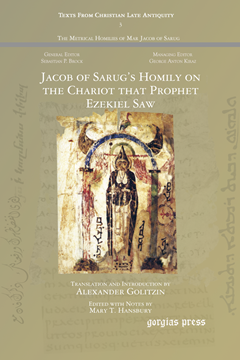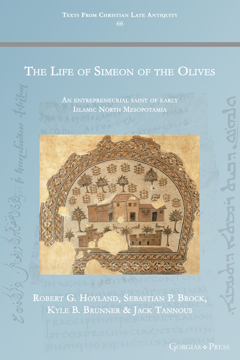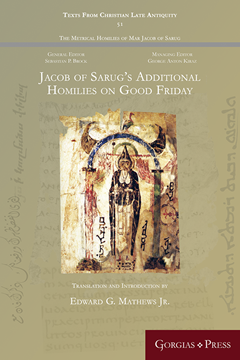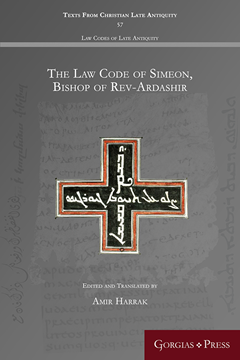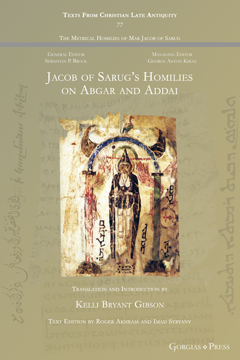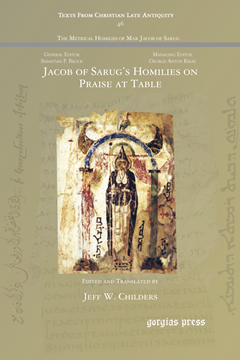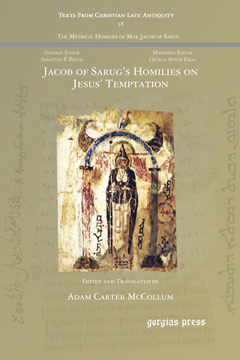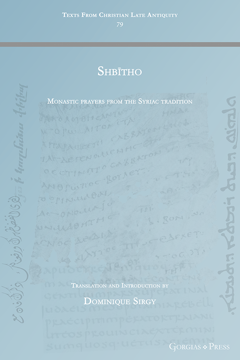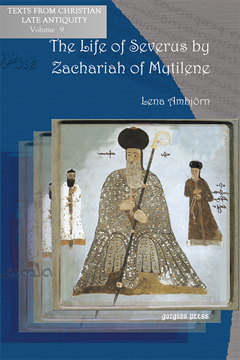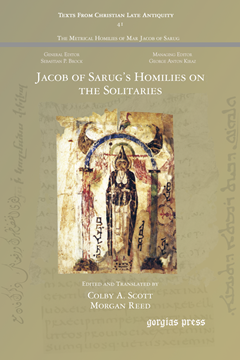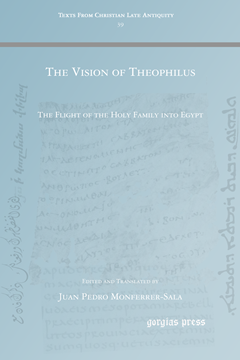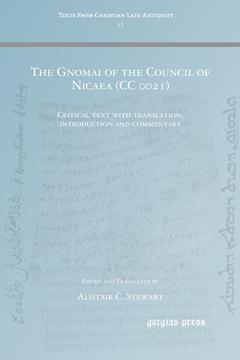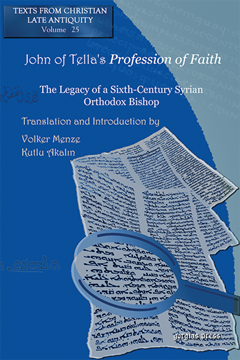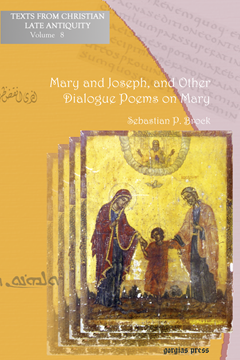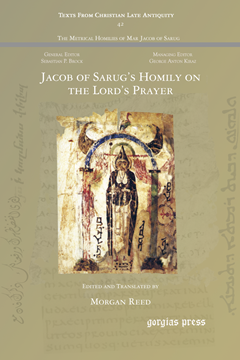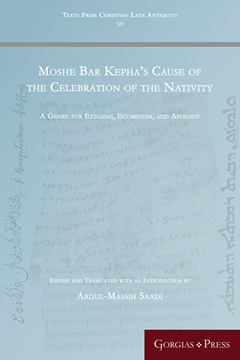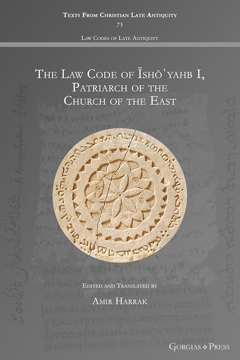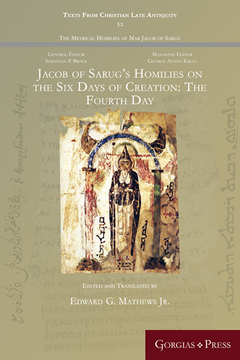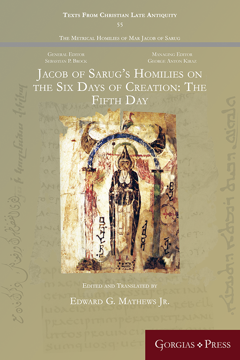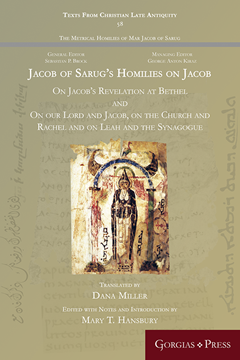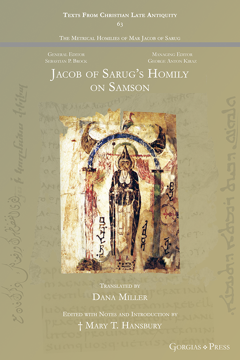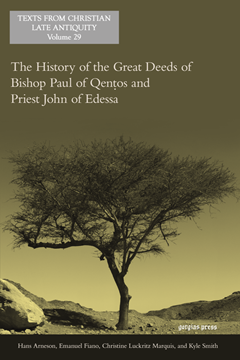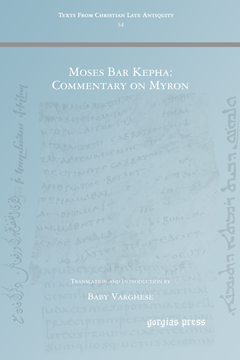Texts from Christian Late Antiquity
TeCLA (Texts from Christian Late Antiquity) is a series presenting ancient Christian texts both in their original languages and with accompanying contemporary English translations.
Jacob of Sarug's Homily on the Chariot that Prophet Ezekiel Saw
Metrical Homilies of Mar Jacob of Sarug
Translation and Introduction by Alexander Golitzin; Edited with Notes by Mary T. Hansbury
Series: Texts from Christian Late Antiquity 3
ISBN: 978-1-59333-735-3
This volume gives a bilingual Syriac-English edition of Saint Jacob of Sarug’s homily on the Chariot which the Prophet Ezekiel saw. The Syriac text is fully vocalized, and the translation is annotated with a commentary and biblical references. The volume constitutes a fascicle of Gorgias’s Complete Homilies of Saint Jacob of Sarug. In Syriac and English.
$50.00 (USD)
The Life of Simeon of the Olives
An entrepreneurial saint of early Islamic North Mesopotamia
Series: Texts from Christian Late Antiquity 66
ISBN: 978-1-4632-4346-3
The first ever critical edition and complete translation of the Syriac Life of Saint Simeon of the Olives, who was an abbot of Qartmin Monastery in Tur Abdin and a bishop of the city of Harran in the late seventh and early eighth century AD.
$50.00 (USD)
Jacob of Sarug's Additional Homilies on Good Friday
Translation and Introduction by Edward G Mathews Jr
Series: Texts from Christian Late Antiquity 51
ISBN: 978-1-4632-0752-6
Two homilies by Jacob of Sarug on Good Friday, one of which has only survived in Armenian translation.
$49.50 (USD)
The Law Code of Simeon, Bishop of Rev-Ardashir
Edited and Translated by Amir Harrak
Series: Texts from Christian Late Antiquity 57
ISBN: 978-1-4632-4134-6
The Law Code of Simeon of Rev-Ardashir, originally written in Persian, was translated into Syriac by a monk of Bēṭ-Qatrāyē. The Code's author, possibly to be identified with a rebellious metropolitan mentioned in the letters of Patriarch Īšoʿ-yahb III, aims to clarify theoretical scriptural law, and to address specific cases of inheritance law.
$48.40 (USD)
Jacob of Sarug’s Homilies on Abgar and Addai
Series: Texts from Christian Late Antiquity 77
ISBN: 978-1-4632-4469-9
Jacob of Sarug's homilies on King Abgar and the Apostle Addai, recounting the famous legend of Abgar of Edessa's conversion to Christianity.
$48.00 (USD)
Jacob of Sarug's Homilies on Praise at Table
Edited and Translated by Jeff W. Childers
Series: Texts from Christian Late Antiquity 46
ISBN: 978-1-4632-0605-5
Part of a series of fascicles containing the bilingual Syriac-English editions of Saint Jacob of Sarug’s homilies, this volume contains his homilies on Praise at Table. These homilies offer a glimpse into the efforts of one late antique author to construct distinctly Christian meaning from the experience of communal meal-sharing. The Syriac text is fully vocalized, and the translation is annotated with a commentary and biblical references. The volume is one of the fascicles of Gorgias Press’s The Metrical Homilies of Mar Jacob of Sarug, which, when complete, will contain all of Jacob’s surviving sermons. Recognized as a saint by both Chalcedonian and non-Chalcedonian Christians alike, Jacob of Sarug (d. 521) produced many narrative poems that have rarely been translated into English. Of his reported 760 metrical homilies, only about half survive.
$47.00 (USD)
Jacob of Sarug’s Homilies on Jesus' Temptation
Edited and Translated by Adam Carter McCollum
Series: Texts from Christian Late Antiquity 38
ISBN: 978-1-4632-0285-9
This volume presents, with introduction and annotations, two metrical homilies (Bedjan nos. 82, 126) of Jacob of Sarug in which he reflects on the Temptation of Jesus as combat between Satan and Jesus, the latter emerging as the humble victor.
$47.00 (USD)
Shbītho
Monastic prayers from the Syriac tradition
Translation and Introduction by Dominique Sirgy
Series: Texts from Christian Late Antiquity 79
ISBN: 978-1-4632-4475-0
The Shbītho d-Dayroye is a thirteenth-century anthology dedicated to the personal prayer of monks and nuns. The collection comprises the writings of great saints in the Syriac Orthodox tradition including Ephrem the Syrian, Abraham Qidun, John Chrysostom, Gregory of Nazianzus, Philoxenos, Basil the Great, and Isaac the Syrian. For each of the seven daily prayer times (morning, third hour, noon, ninth hour, evening, and night), there is a main prayer and a closing prayer. The present edition is the first translation to make the spiritual treasures of the original Syriac text available to readers in English.
$45.00 (USD)
The Life of Severus by Zachariah of Mytilene
By Lena Ambjörn
Series: Texts from Christian Late Antiquity 9
ISBN: 978-1-59333-841-1
This biography of Severus, the patriarch of Antioch from 512-518 CE, attributed to his schoolmate Zachariah of Mytilene, gives unique information about life in Mediterranean region in the second half of the 5th century. These two young men from wealthy families became involved with a Christian movement, the "philoponoi," "those devoted to work" who combined asceticism with theological study. The work, originally in Greek, survives only in Syriac, which this volume presents alongside the first English translation of it. It is an important source for studies on Ancient Biography, Late Antiquity, and Early Christianity.
$44.00 (USD)
Jacob of Sarug's Homilies on the Solitaries
Edited and Translated by Colby A. Scott & Morgan Reed
Series: Texts from Christian Late Antiquity 41
ISBN: 978-1-4632-0562-1
Jacob of Sarug's pastoral concern and rhetorical acumen have appropriately earned him the title “the lyre of the Holy Spirit”. This volume presents Jacob's admonitions to those living a life of consecrated singleness to God.
$44.00 (USD)
The Vision of Theophilus
The Flight of the Holy Family into Egypt
Edited and Translated by Juan Pedro Monferrer-Sala
Series: Texts from Christian Late Antiquity 39
ISBN: 978-1-4632-0550-8
A critical edition of a fragmentary Arabic manuscript (Mingana Chr. Arab. 18), together with a study which suggests that the three Arabic versions do not represent three different texts, but rather three versions all drawing on the same original text.
$43.00 (USD)
The Gnomai of the Council of Nicaea (CC 0021)
Critical text with translation, introduction and commentary
Edited and Translated by Alistair C. Stewart
Series: Texts from Christian Late Antiquity 35
ISBN: 978-1-4632-0260-6
The first English translation and first complete critical text of a neglected moral treatise from fourth-century Egypt, throwing fresh light on the social history of Egyptian Christianity and on the growth of the church-order tradition.
$43.00 (USD)
John of Tella’s Profession of Faith
The Legacy of a Sixth-Century Syrian Orthodox Bishop
Translation and Introduction by Volker Menze & Kutlu Akalın
Series: Texts from Christian Late Antiquity 25
ISBN: 978-1-59333-843-5
John became bishop of Tella in 519, but left for exile only two years later when Justin I enforced the Council of Chalcedon which Syrian Orthodox Christians refused to accept. John became one of Justinian’s most dangerous ecclesiastical opponents by ordaining thousands of deacons and priests who formed the first generation of the Syrian Orthodox hierarchy. In the present text John lays out his faith in a way which gives an inside view of how a non-Chalcedonian bishop of the sixth century located himself and his co-religionists within the Christian tradition and how he understood the foundation of the Church.
$43.00 (USD)
Ephrem the Syrian's Hymns on the Unleavened Bread
Translation and Introduction by J. Edward Walters
Series: Texts from Christian Late Antiquity 30
ISBN: 978-1-4632-0159-3
In this set of homilies Ephrem (306-373) invites the reader into a world of symbolic interpretation filled with imagination brimming beneath the surface of word-plays, alliteration, and typological comparisons. These hymns thrust the reader into the middle of a context in which Christians and Jews maintain competing practices of a Passover service to the extent that Ephrem feels the need to distinguish between the symbol and the reality. These homilies are presented in their Syriac original alongside an annotated English translation.
$41.00 (USD)
Mary and Joseph, and Other Dialogue Poems on Mary
Series: Texts from Christian Late Antiquity 8
ISBN: 978-1-59333-839-8
What was Joseph’s reaction when he arrived home to find Mary pregnant? How did Mary manage to persuade him that her child was none other than the Son of God? The Syriac literary tradition had a unique way of answering these sorts of questions raised by the Bible. Dialogue poems (sughyotho) offer lively, thought-provoking, and often delightful re-imaginings of Biblical events. They expand the Biblical stories, giving the familiar characters more dialogue and describing their inner thoughts. The collection provides five dialogue poems featuring Mary, in Syriac original with facing English translation.
$40.00 (USD)
Jacob of Sarug's Homily on the Lord's Prayer
Edited and Translated by Morgan Reed
Series: Texts from Christian Late Antiquity 42
ISBN: 978-1-4632-0561-4
Jacob of Sarug's pastoral concern and rhetorical acumen have earned him the title “the lyre of the Holy Spirit”. This volume presents both a text and translation of Jacob’s exposition of a passage central to Christian liturgy and piety.
$39.00 (USD)
Moshe Bar Kepha’s Cause of the Celebration of the Nativity
A Genre for Exegesis, Ecumenism, and Apology
Edited and Translated with an Introduction by Abdul-Massih Saadi
Series: Texts from Christian Late Antiquity 50
ISBN: 978-1-4632-0733-5
This book is a part of series of Causes of Celebrations written by Moshe Bar Kepha (813-903). These Causes are unique in that they demonstrate a new genre of the Syriac literature initiated by the East Syriac authors at the beginning of the sixth century. Moreover, these Causes reveal the appreciation and dependency of Moshe Bar Kepha on the East Syriac sources despite the ecclesiastical doctrinal separation between the East Syriac and West Syriac churches.
$39.00 (USD)
The Law Code of Īshōʿyahb I, Patriarch of the Church of the East
Edited and Translated by Amir Harrak
Series: Texts from Christian Late Antiquity 75
ISBN: 978-1-4632-4434-7
During the 6th century AD, Īshōʿyahb I, Patriarch of the Church of the East, produced a code of law dealing with questions raised by Bishop Jacob of Darai in the Gulf. Perennial Church issues include priestly conducts, ecclesiastical rankings, and ordinations. Legal matters for the faithful concern wills, marriages, vows, lending at interest, and swearing. Most interesting are names of church architecture that the Code gives, including bema, diaconicon, and qestroma, terms that are still used today.
$39.00 (USD)
Jacob of Sarug’s Homilies on the Six Days of Creation (The Sixth Day)
The Sixth Day
Edited and Translated by Edward G Mathews Jr
Series: Texts from Christian Late Antiquity 59
ISBN: 978-1-4632-4211-4
In this sixth installment of the long Homily 71, On the Six Days of Creation, Jacob treats the events of the sixth day.
$38.50 (USD)
Jacob of Sarug’s Homilies on the Six Days of Creation (The Fourth Day)
The Fourth Day
Edited and Translated by Edward G Mathews Jr
Series: Texts from Christian Late Antiquity 52
ISBN: 978-1-4632-3912-1
In this fourth installment of the long Homily 71, On the Six Days of Creation, Jacob treats of the events of the fourth day, the creation of the spheres of light over the earth: the sun to rule over the day, and the moon and the stars to rule over the night.
$38.50 (USD)
Jacob of Sarug’s Homilies on the Six Days of Creation (The Fifth Day)
The Fifth Day
Edited and Translated by Edward G Mathews Jr
Series: Texts from Christian Late Antiquity 55
ISBN: 978-1-4632-4117-9
In this fifth installment of the long Homily 71, On the Six Days of Creation, Jacob treats of the events of the fifth day, the creation from the waters of the various species of fish and reptiles, as well as the assorted types of birds and other winged creatures. God created them all in wisdom and in love, prepared everything that they would need and endowed them with the natural characteristics required for their particular type of life. Jacob highlights the fact that the creation of these animals on the fifth day to inhabit the land and water separated on the third day is a symbol of the Resurrection of Christ.
$38.50 (USD)
Jacob of Sarug's Homilies on Jacob
On Jacob’s Revelation at Bethel and On our Lord and Jacob, on the Church and Rachel and on Leah and the Synagogue
Translated by Dana Miller; Edited with Notes and Introduction by Mary T. Hansbury
Series: Texts from Christian Late Antiquity 58
ISBN: 978-1-4632-4189-6
Recognized as a saint by both Chalcedonian and non-Chalcedonian Christians alike, Jacob of Sarug (d. 521) produced many narrative poems that have rarely been translated into English. Of his reported 760 metrical homilies, only about half survive. Part of a series of fascicles containing the bilingual Syriac-English editions of Saint Jacob of Sarug’s homilies, this volume contains two of his homilies on Jacob. The Syriac text is fully vocalized, and the translation is annotated with a commentary and biblical references. The volume is one of the fascicles of Gorgias Press’s Complete Homilies of Saint Jacob of Sarug, which, when complete, will contain all of Jacob’s surviving sermons.
$38.00 (USD)
Jacob of Sarug's Homily on Samson
Edited with Notes and Introduction by Mary T. Hansbury; Translated by Dana Miller
Series: Texts from Christian Late Antiquity 63
ISBN: 978-1-4632-4290-9
Recognized as a saint by both Chalcedonian and non-Chalcedonian Christians alike, Jacob of Sarug (d. 521) produced many narrative poems that have rarely been translated into English. Of his reported 760 metrical homilies, only about half survive. Part of a series of fascicles containing the bilingual Syriac-English editions of Saint Jacob of Sarug’s homilies, this volume contains his homily on Samson. The Syriac text is fully vocalized, and the translation is annotated with a commentary and biblical references. The volume is one of the fascicles of Gorgias Press’s Complete Homilies of Saint Jacob of Sarug, which, when complete, will contain all of Jacob’s surviving sermons.
$38.00 (USD)
The History of the Great Deeds of Bishop Paul of Qentos and Priest John of Edessa
Series: Texts from Christian Late Antiquity 29
ISBN: 978-1-60724-670-1
Desiring to lead an ascetic life during the 5th century, Paul abandons his bishopric in Italy and travels to Edessa. John realizes that Paul is a wonderworker, and so begs to accompany him on his travels. The two leave Edessa to visit the monks on Sinai, but instead of reaching their destination they are abducted and taken to Yemen by tree-worshipping Arabs. After a battle with a tree-god, they succeed in converting the Arabs to Christianity. During the journey home, they encounter a wandering band of monks among whom is a woman disguised as a man.
$38.00 (USD)
Commentary on Myron
Translation and Introduction by Fr. Baby Varghese
Series: Texts from Christian Late Antiquity 34
ISBN: 978-1-4632-0214-9
Moses bar Kepha: Commentary on Myron is an important witness to the history of the West Syriac Liturgy. Fr. Baby Varghese has translated the Syriac text into English for the first time.
$37.00 (USD)

